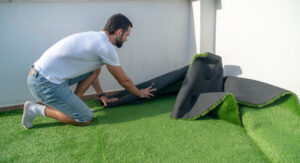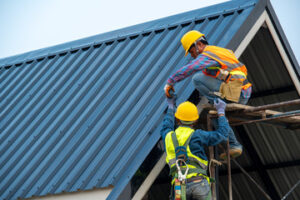Artificial Turf Installation Colorado Springs offer many benefits. It’s a great choice for individuals with allergies to natural grasses that can cause headaches and sneezing.
Turf installation requires a professional for proper base preparation and other steps. Unethical crews may cut corners during turf base preparation, resulting in gaps and ponding.
Artificial Turf is a great alternative for sports fields that need to be able to withstand the inclement weather that can impact natural grass. Keystone can provide custom turf solutions, allowing a field to play through home runs, touchdowns, goals, and finishes, even when the weather is uncooperative. In addition to sports play, turf can be used for golf course greens and playground surfaces.
One of the most important parts of a successful turf installation is making sure that the ground has been prepared properly. It is important to remove any existing grass, as laying down turf directly on top of soil can lead to drainage problems. This is because water that normally drains, evaporates or absorbs into the soil can collect underneath the turf, causing it to become saturated and damaged.
It is also important to lay down a weed barrier layer before laying out the synthetic grass. This will help inhibit any weeds that may grow up through the base of the turf, as well as prevent dirt from shifting and losing compaction over time. This step is optional, but it is often recommended for areas where the soil tends to be weedy or have issues with shifts in the soil.
When preparing the ground, it is also important to make sure that it has been properly compacted with a vibrating plate or professional compactor. This will help ensure that the base is as smooth and consistent as possible, which helps to create a better surface for the turf. It is important to note that over time, a base that has not been compacted can cause the turf to develop ruts and bumps that will affect performance and appearance.
Once the ground has been prepared, it is time to roll out the turf and start seaming it together. When spotting the location for the seam, it is important to remember that the blade fall of the turf should be toward the area that will receive more traffic. This will ensure that the turf stays strong and durable over time.
Laying Out the Turf
Once the soil is prepared, the next step in installing artificial turf is to lay out the turf. Unlike natural grass, which can grow up through the turf, synthetic lawns are laid over a base, which helps to prevent weeds and maintain a firm surface.
It’s important to use the right amount of base material, especially in the corners and around obstructions. Adding too much fill can result in dips or uneven areas that may not be easily fixed later on. It’s also a good idea to add a layer of builder’s sand, which will help to keep dirt from leaking through the turf.
The sand should be lightly tamped down with a hand tamper or vibratory plate compactor, and then graded. This will level and smooth the soil to prevent bumps under the turf that might cause it to rip or shift later on. It’s a good idea to also place a weed barrier over the sand, which will reduce the chances of weeds growing up through the turf in the future.
Turf is heavy and difficult for one person to manage, so it’s best to have several people working together. It’s also a good idea for the first few rolls to be left in the sun for an hour or so before being unrolled, which will make them more pliable and easier to work with.
When laying the turf, it’s important that all of the pieces of turf have their edges seam together properly to create a seamless look. This can be accomplished by using quality turf glue or seaming tape. Depending on the brand of the product, there are usually specific instructions for how to apply it, so be sure to follow them closely.
Once the seams are in place, it’s a good idea to set some nails around the perimeter of the turf. This will prevent it from shifting or peeling away when children and pets play. For low-traffic areas, 3-4” spikes will be sufficient, but for higher-traffic areas it may be best to use longer ones. Also, it’s a good idea to fasten the turf to the ground with nails every 3″-4″ along the perimeters and every 12″-24″ throughout the field.
Fastening the Turf
After you’ve prepared the base and compacted it, it’s time to install the turf. Artificial turf comes in large, heavy rolls that are difficult for one person to handle. If you are unable to get help with transporting the rolls, leave them in the sun for an hour or so before unrolling to make them more pliable and easier to maneuver. When you’re ready to roll it out, cut it to the appropriate size with a utility knife or turf cutting tool. You will probably want to leave a few extra inches around the edges to tuck under borders and walkways or for seaming later on, but you also don’t want it too short.
Whether you’re installing the lawn over soil or another hard surface, it’s wise to lay down a shock pad. This will cushion the impact from anyone falling on the grass and prevent injury to children and pets. You should also grade flat surfaces, sloping them to drain away from the lawn. This will prevent moisture buildup under the turf that could lead to mold and mildew and possibly cause a flood.
It’s also a good idea to install a barrier under the base. This can prevent weeds from growing up through the back of the turf and save you money on weed killer in the future. It can also prevent the movement of soil that may result in sinkholes or flooding during rainstorms.
If you’re installing the turf over concrete, it’s not necessary to add a weed barrier, but you can still use a landscape pin or spike every 6-8 inches along the perimeter. Make sure you set the stakes firmly without driving them too deep, or you might create dips in your fake grass.
You can also install a border around the edge of your lawn to keep it from slumping or separating over time. A plastic bender board is an inexpensive and effective option, but you can also choose to pour a concrete curb around the area. If you do this, be sure that the curb won’t protrude above the turf level and inhibit drainage.
Infilling the Turf
It’s essential that you use the right type of infill to give your turf its full and luscious look. Infill also helps the fibers stand up, preventing them from flattening out over time and making your lawn less attractive. The infill should also improve the drainage of your synthetic grass and prevent any unwanted weed growth. Silica sand is the most commonly used infill during artificial turf installation. This affordable option provides the necessary support for your turf, but it can become clumped together over time and decrease the permeability of the soil. It’s important to use a silica sand that is kiln-dried to reduce the risk of contamination and prevent unwanted weed growth.
If you have a large yard, you may need to spread your infill over more than one section of your turf. To make this process easier, you can rent a drop spreader at most hardware stores or home improvement centers. Fill the spreader with a comfortable weight of infill and begin applying it to your turf. You can work in a parallel or criss-cross pattern, depending on the size of your yard and how evenly you want your infill to be applied. When you’re finished, brush the infill deep into the surface of your synthetic turf and check for any granules that are still on top of the surface.
Before you begin laying your turf, it’s a good idea to spray the area with a good weed killer. This will help you avoid catching off guard with stubborn weeds that the weed killer can’t kill. It’s also a good idea to contact your local utility company and have them come out to mark your property lines so that you don’t accidentally dig into gas, water, or electric pipes.

 When looking for a new roof, you want to ensure you are dealing with a reputable and qualified contractor. You want to avoid ending up with a shoddy product or, worse yet, having to pay for repairs to your roof because the installer needed to follow the proper procedures. The best way to ensure a quality installation is to hire a GAF factory-certified expert roofer. These contractors have undergone extensive training and can perform the most complex and important tasks correctly. They are also able to offer an enhanced warranty on your new roofing system.
When looking for a new roof, you want to ensure you are dealing with a reputable and qualified contractor. You want to avoid ending up with a shoddy product or, worse yet, having to pay for repairs to your roof because the installer needed to follow the proper procedures. The best way to ensure a quality installation is to hire a GAF factory-certified expert roofer. These contractors have undergone extensive training and can perform the most complex and important tasks correctly. They are also able to offer an enhanced warranty on your new roofing system. A properly working gutter can prevent mold from growing on your foundation. It can even help protect your grass from getting wet.
A properly working gutter can prevent mold from growing on your foundation. It can even help protect your grass from getting wet. 
